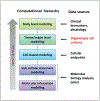Systems biology for organotypic cell cultures
- PMID: 27846345
- PMCID: PMC12127970
- DOI: 10.14573/altex.1608221
Systems biology for organotypic cell cultures
Abstract
Translating in vitro biological data into actionable information related to human health holds the potential to improve disease treatment and risk assessment of chemical exposures. While genomics has identified regulatory pathways at the cellular level, translation to the organism level requires a multiscale approach accounting for intra-cellular regulation, inter-cellular interaction, and tissue/organ-level effects. Tissue-level effects can now be probed in vitro thanks to recently developed systems of three-dimensional (3D), multicellular, "organotypic" cell cultures, which mimic functional responses of living tissue. However, there remains a knowledge gap regarding interactions across different biological scales, complicating accurate prediction of health outcomes from molecular/genomic data and tissue responses. Systems biology aims at mathematical modeling of complex, non-linear biological systems. We propose to apply a systems biology approach to achieve a computational representation of tissue-level physiological responses by integrating empirical data derived from organotypic culture systems with computational models of intracellular pathways to better predict human responses. Successful implementation of this integrated approach will provide a powerful tool for faster, more accurate and cost-effective screening of potential toxicants and therapeutics. On September 11, 2015, an interdisciplinary group of scientists, engineers, and clinicians gathered for a workshop in Research Triangle Park, North Carolina, to discuss this ambitious goal. Participants represented laboratory-based and computational modeling approaches to pharmacology and toxicology, as well as the pharmaceutical industry, government, non-profits, and academia. Discussions focused on identifying critical system perturbations to model, the computational tools required, and the experimental approaches best suited to generating key data.
Keywords: 3D models; engineered cell cultures; multiscale modeling; systems pharmacology; systems toxicology.
Conflict of interest statement
Conflict of interest
The authors declare that they have no conflicts of interest.
Figures





References
MeSH terms
Substances
Grants and funding
LinkOut - more resources
Full Text Sources
Other Literature Sources
Miscellaneous

